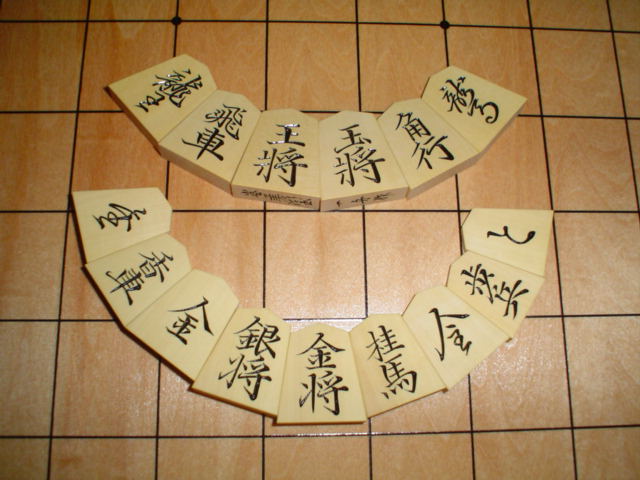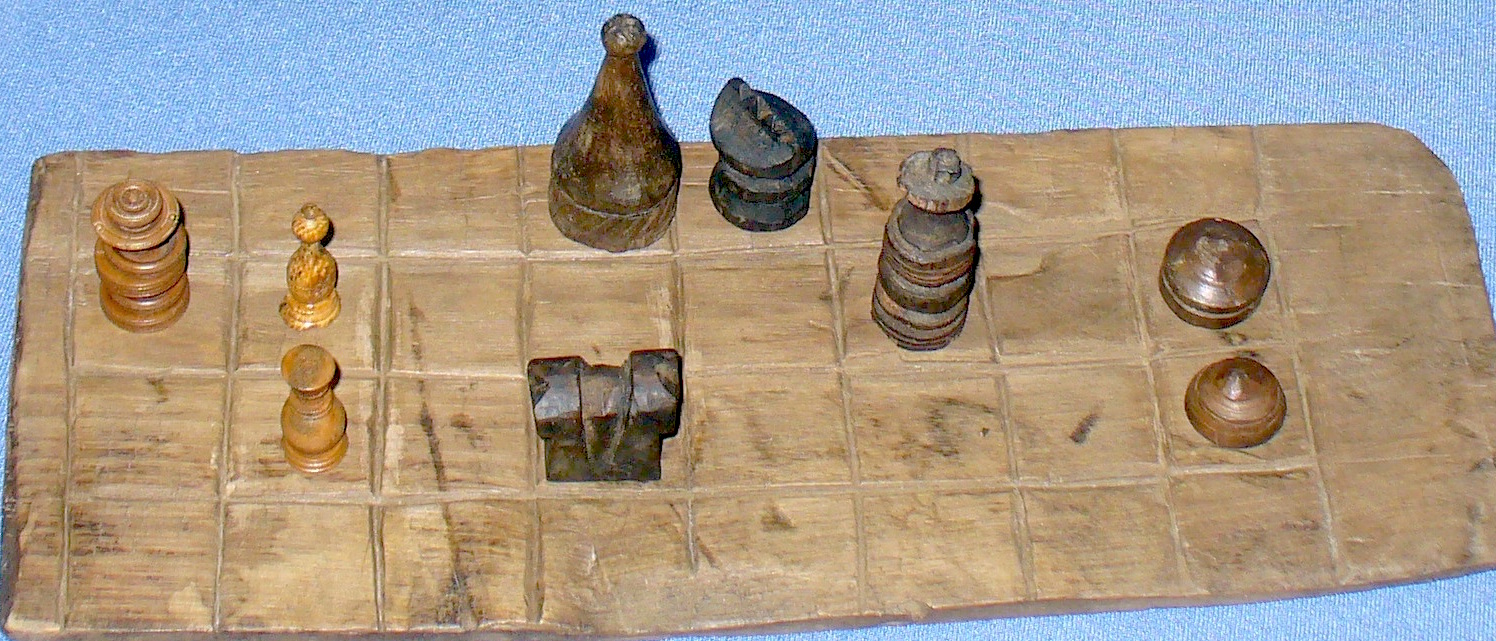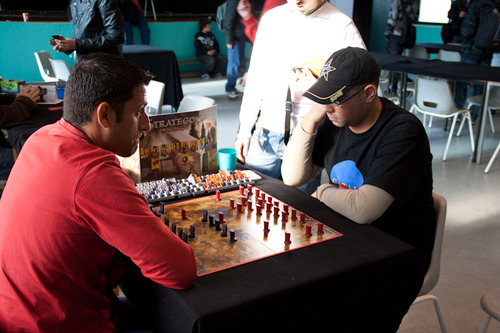|
Shogi
, also known as Japanese chess, is a Strategy game, strategy board game for two players. It is one of the most popular board games in Japan and is in the same family of games as chess, Western chess, chaturanga, xiangqi, Indian chess, and janggi. ''Shōgi'' means general's (''shō'' ) board game (''gi'' ). Shogi was the earliest historical chess-related game to allow captured pieces to be returned to the board by the capturing player. This ''drop rule'' is speculated to have been invented in the 15th century and possibly connected to the practice of 15th-century Mercenary#15th to 18th centuries, mercenaries switching loyalties when captured instead of being killed. The earliest predecessor of the game, chaturanga, originated in India in the 6th century, and the game was likely transmitted to Japan via China or Korea sometime after the Nara period."Shogi". ''Encyclopædia Britannica''. 2002. Shogi in its present form was played as early as the 16th century, while a direct ancesto ... [...More Info...] [...Related Items...] OR: [Wikipedia] [Google] [Baidu] |
Shogi Ban Koma
, also known as Japanese chess, is a strategy board game for two players. It is one of the most popular board games in Japan and is in the same family of games as Western chess, chaturanga, xiangqi, Indian chess, and janggi. ''Shōgi'' means general's (''shō'' ) board game (''gi'' ). Shogi was the earliest historical chess-related game to allow captured pieces to be returned to the board by the capturing player. This ''drop rule'' is speculated to have been invented in the 15th century and possibly connected to the practice of 15th-century mercenaries switching loyalties when captured instead of being killed. The earliest predecessor of the game, chaturanga, originated in India in the 6th century, and the game was likely transmitted to Japan via China or Korea sometime after the Nara period."Shogi". ''Encyclopædia Britannica''. 2002. Shogi in its present form was played as early as the 16th century, while a direct ancestor without the drop rule was recorded from 1210 in a his ... [...More Info...] [...Related Items...] OR: [Wikipedia] [Google] [Baidu] |
Shogi Notation
Shogi notation is the set of various abbreviatory notational systems used to describe the piece movements of a shogi game record or the positions of pieces on a shogi board. A record of an abstract strategy game, abstract strategy board game such as shogi is called in Japanese. Recording moves Western notation The system used in English language texts to express shogi moves was established by George Hodges (shogi), George Hodges and Glyndon Townhill in 1976 by the second issue of ''Shogi'' magazine. A slightly modified version was used in . It is derived from the Algebraic chess notation, algebraic notation used for chess, but differs in several respects. A typical move might be notated P86 or P-8f. The notation format has the following 5 part structure: : An example using all 5 parts is S72x83+ or S7bx8c+. All parts are obligatory except for the ''origin'' and ''promotion'' parts. (Thus, most notation strings only contain 3 parts.) The ''origin'' part is only indicated ... [...More Info...] [...Related Items...] OR: [Wikipedia] [Google] [Baidu] |
Shogi Strategy And Tactics
Shogi, like western chess, can be divided into the shogi opening, opening, middle game and endgame, each requiring a different strategy. The opening consists of arranging one's defenses and positioning for attack, the middle game consists of attempting to break through the opposing defenses while maintaining one's own, and the endgame starts when one side's defenses have been compromised. Tactics Many basic tactics (手筋 ''tesuji'') of shogi are similar to those of chess tactics, involving forks, pins, removing the defender and other techniques, all of which are considered very strong when used effectively. However, other tactics, particularly ones involving dropped pieces, have no parallel in western chess. Relative piece value Shogi pieces may be considered to have different valuations in which some pieces are generally more ''valuable'' than others – all other things being equal. (Cf. Chess piece relative value, piece value in western chess.) There are three main valua ... [...More Info...] [...Related Items...] OR: [Wikipedia] [Google] [Baidu] |
Fortress Opening
Fortress (矢倉 or 櫓 ''yagura'') is both a Static Rook opening (矢倉戦法 ''yagura senpō'') and a Castle (shogi), castle in shogi. It is usually played in a Double Static Rook opening, which is often a Double Fortress opening. However, it may also occur in different Double Static Rook openings such as Fortress vs Right Fourth File Rook. The Fortress castle (矢倉囲い ''yagura gakoi''), which is the defining characteristic of Fortress games, was considered by many to be one of the strongest defensive positions in Double Static Rook games in the 1980s. The term ''Yagura (tower), yagura'' is the Japanese word for a tower-like structure in traditional Japanese castles. Double Fortress The most commonly encountered Fortress strategies occur in Double Fortress games where both players use a Fortress formation. Historical Fortress Earlier josekis for Fortress in the Edo period (usually spelled 櫓 at that time) were very different from the current josekis. For ins ... [...More Info...] [...Related Items...] OR: [Wikipedia] [Google] [Baidu] |
Fairy Chess Piece
A fairy chess piece, variant chess piece, unorthodox chess piece, or heterodox chess piece is a chess piece not used in conventional chess but incorporated into certain chess variants and some unorthodox chess problems, known as fairy chess. Compared to conventional pieces, fairy pieces vary mostly in Rules of chess#Movement, the way they move, but they may also follow special rules for capturing, promotions, etc. Because of the distributed and uncoordinated nature of unorthodox chess development, the same piece can have different names, and different pieces can have the same name in various contexts. Most are symbolised as inverted or rotated icons of the standard pieces in diagrams, and the meanings of these "wildcards" must be defined in each context separately. Pieces invented for use in chess variants rather than problems sometimes instead have special icons designed for them, but with some exceptions (the princess (chess), princess, empress (chess), empress, and occasionally a ... [...More Info...] [...Related Items...] OR: [Wikipedia] [Google] [Baidu] |
Abstract Strategy Game
An abstract strategy game is a type of strategy game that has minimal or no narrative theme, an outcome determined only by player choice (with minimal or no randomness), and in which each player has perfect information about the game. For example, Go is a pure abstract strategy game since it fulfills all three criteria; chess and related games are nearly so but feature a recognizable theme of ancient warfare; and Stratego is borderline since it is deterministic, loosely based on 19th-century Napoleonic warfare, and features concealed information. Definition Combinatorial games have no randomizers such as dice, no simultaneous movement, nor hidden information. Some games that do have these elements are sometimes classified as abstract strategy games. (Games such as '' Continuo'', Octiles, '' Can't Stop'', and Sequence, could be considered abstract strategy games, despite having a luck or bluffing element.) A smaller category of abstract strategy games manages to incorporate hidde ... [...More Info...] [...Related Items...] OR: [Wikipedia] [Google] [Baidu] |
Janggi
Janggi (, also Romanization of Korean, romanized as ''changgi'' or ''jangki''), sometimes called Korean chess, is a Strategy game, strategy board game popular on the Korean Peninsula. The game was derived from xiangqi (Chinese chess), and is very similar to it, including the starting position of some of the pieces, and the 9×10 gameboard, but without the xiangqi "river" dividing the board horizontally in the middle. Janggi is played on a board nine lines wide by ten lines long. The game is sometimes fast paced due to the jumping cannons and the long-range elephants, but professional games most often last over 150 moves and so are typically slower than those of Chess, Western chess. In 2009, the first world janggi tournament was held in Harbin, Heilongjiang, China. Rules Board The board is composed of 90 intersections of 9 vertical files and 10 horizontal rows. The board has nearly the same layout as that used in xiangqi, except the janggi board has no "river" in the central ... [...More Info...] [...Related Items...] OR: [Wikipedia] [Google] [Baidu] |
Board Game
A board game is a type of tabletop game that involves small objects () that are placed and moved in particular ways on a specially designed patterned game board, potentially including other components, e.g. dice. The earliest known uses of the term "board game" are between the 1840s and 1850s. While game boards are a necessary and sufficient condition of this genre, card games that do not use a standard deck of cards, as well as games that use neither cards nor a game board, are often colloquially included, with some referring to this genre generally as "table and board games" or simply "tabletop games". Eras Ancient era Board games have been played, traveled, and evolved in most cultures and societies throughout history Board games have been discovered in a number of archaeological sites. The oldest discovered gaming pieces were discovered in southwest Turkey, a set of elaborate sculptured stones in sets of four designed for a chess-like game, which were created during the ... [...More Info...] [...Related Items...] OR: [Wikipedia] [Google] [Baidu] |
Rook (chess)
The rook (; ♖, ♜) is a piece in the game of chess. It may move any number of squares horizontally or vertically without jumping, and it may an enemy piece on its path; it may participate in castling. Each player starts the game with two rooks, one in each corner on their side of the board. Formerly, the rook (from ) was alternatively called the ''tower'', ''marquess'', ''rector'', and ''comes'' (''count'' or ''earl''). The term "castle" is considered to be informal or old-fashioned. Placement and movement The white rooks start on the squares a1 and h1, while the black rooks start on a8 and h8. The rook moves horizontally or vertically, through any number of unoccupied squares. The rook cannot jump over pieces. The rook may capture an enemy piece by moving to the square on which the enemy piece stands, removing it from play. The rook also participates with the king in a special move called castling, wherein it is transferred to the square crossed by the king after th ... [...More Info...] [...Related Items...] OR: [Wikipedia] [Google] [Baidu] |
Old Japanese
is the oldest attested stage of the Japanese language, recorded in documents from the Nara period (8th century). It became Early Middle Japanese in the succeeding Heian period, but the precise delimitation of the stages is controversial. Old Japanese was an early member of the Japonic language family. No genetic links to other language families have been proven. Old Japanese was written using man'yōgana, which is a writing system that employs Chinese characters as syllabograms or (occasionally) logograms. It featured a few phonemic differences from later forms, such as a simpler syllable structure and distinctions between several pairs of syllables that have been pronounced identically since Early Middle Japanese. The phonetic realization of these distinctions is uncertain. Internal reconstruction points to a pre-Old Japanese phase with fewer consonants and vowels. As is typical of Japonic languages, Old Japanese was primarily an agglutinative language with a subject–obj ... [...More Info...] [...Related Items...] OR: [Wikipedia] [Google] [Baidu] |






